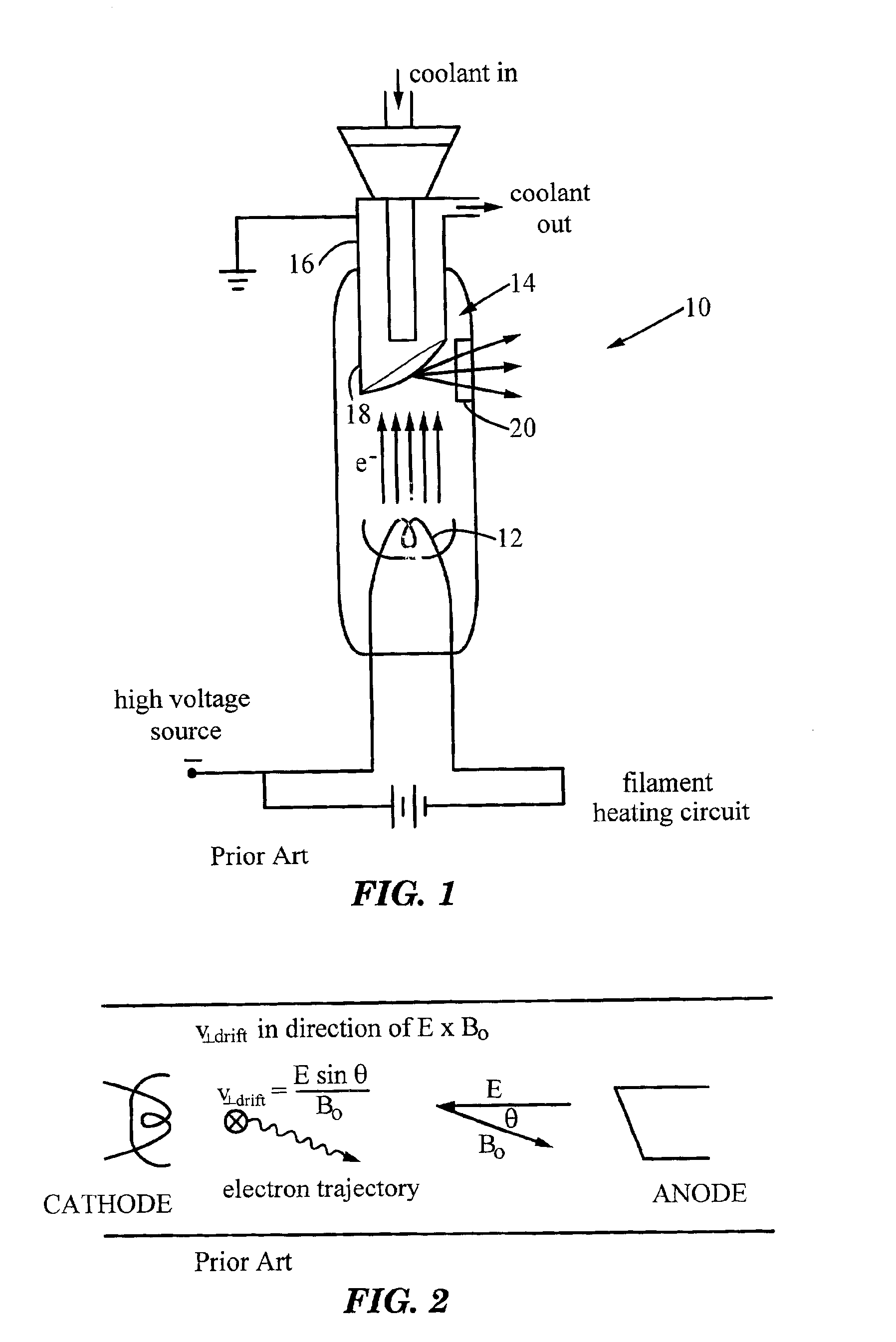Modified X-ray tube for use in the presence of magnetic fields
a magnetic field and x-ray tube technology, applied in the field of medical systems, can solve the problems of inability to use near, let alone inside, a mri system, and the patient is moved
- Summary
- Abstract
- Description
- Claims
- Application Information
AI Technical Summary
Benefits of technology
Problems solved by technology
Method used
Image
Examples
first embodiment
[0040]FIG. 4 shows an x-ray source 60 of the invention, referred to as the electrostatic deflection embodiment. In the x-ray source 60, the electron beam is steered 30 using electrostatic plates 62 and 64 around an x-ray tube 66 and separated by a distance d. The plates 62 and 64 are parallel to each other and at an angle θ with the axis of the tube 66. θ is the angle between the main magnetic field B0 and the electric field between the anode and cathode; that is, the plates 62 and 64 are parallel to B0. An electric potential V is applied between the two plates, creating an approximately uniform electric field Eplate of magnitude V / d within the tube. The electric field Eplate exerts a force on an electron in the beam of magnitude FE=eV / d, where e is the electron charge, directed toward the higher potential plate. The position of and electric potential between the plates 62 and 64 is selected to oppose the component of the main electric field E (between anode and cathode) that is per...
second embodiment
[0043]FIG. 5 shows an x-ray source 70 of the present invention, referred to as the electromagnetic deflection embodiment. In this embodiment, the electron beam is steered toward the target using an electromagnet, coils 72 positioned around the outside of an x-ray tube 74. Each coil 72 contains N turns of wire, and the coils are separated by their radius r. Current flowing through the coils 72 generates an additional magnetic field Bcoil within the tube 74 that opposes the component of the static magnetic field perpendicular to the tube axis. Optimal focusing of the electron beam on the target is provided when the net magnetic field in the tube is directed along the tube axis, i.e., when the component of the magnetic field perpendicular to the tube axis is zero. In the electromagnetic deflection embodiment, the current I in the coils 72 is selected so that the sum of the coil magnetic field Bcoil and the static magnetic field B0 is directed only along the tube axis. For example, as s...
third embodiment
[0053]an x-ray source 80 is shown in FIG. 6. In this embodiment, a small amount of magnetic material 82 is placed behind the anode 84 of the x-ray tube 86, i.e., on the side opposite the side on which the electrons collide with the target. Because the magnetic material 82 has a large magnetization in the applied magnetic field, it distorts the local magnetic field lines near the anode 84 so that more magnetic field lines go through the focal spot on the target. The locally distorted magnetic field acts to increase the focusing of the electrons on the anode target. Any suitable magnetic material can be used.
PUM
 Login to View More
Login to View More Abstract
Description
Claims
Application Information
 Login to View More
Login to View More - R&D
- Intellectual Property
- Life Sciences
- Materials
- Tech Scout
- Unparalleled Data Quality
- Higher Quality Content
- 60% Fewer Hallucinations
Browse by: Latest US Patents, China's latest patents, Technical Efficacy Thesaurus, Application Domain, Technology Topic, Popular Technical Reports.
© 2025 PatSnap. All rights reserved.Legal|Privacy policy|Modern Slavery Act Transparency Statement|Sitemap|About US| Contact US: help@patsnap.com



